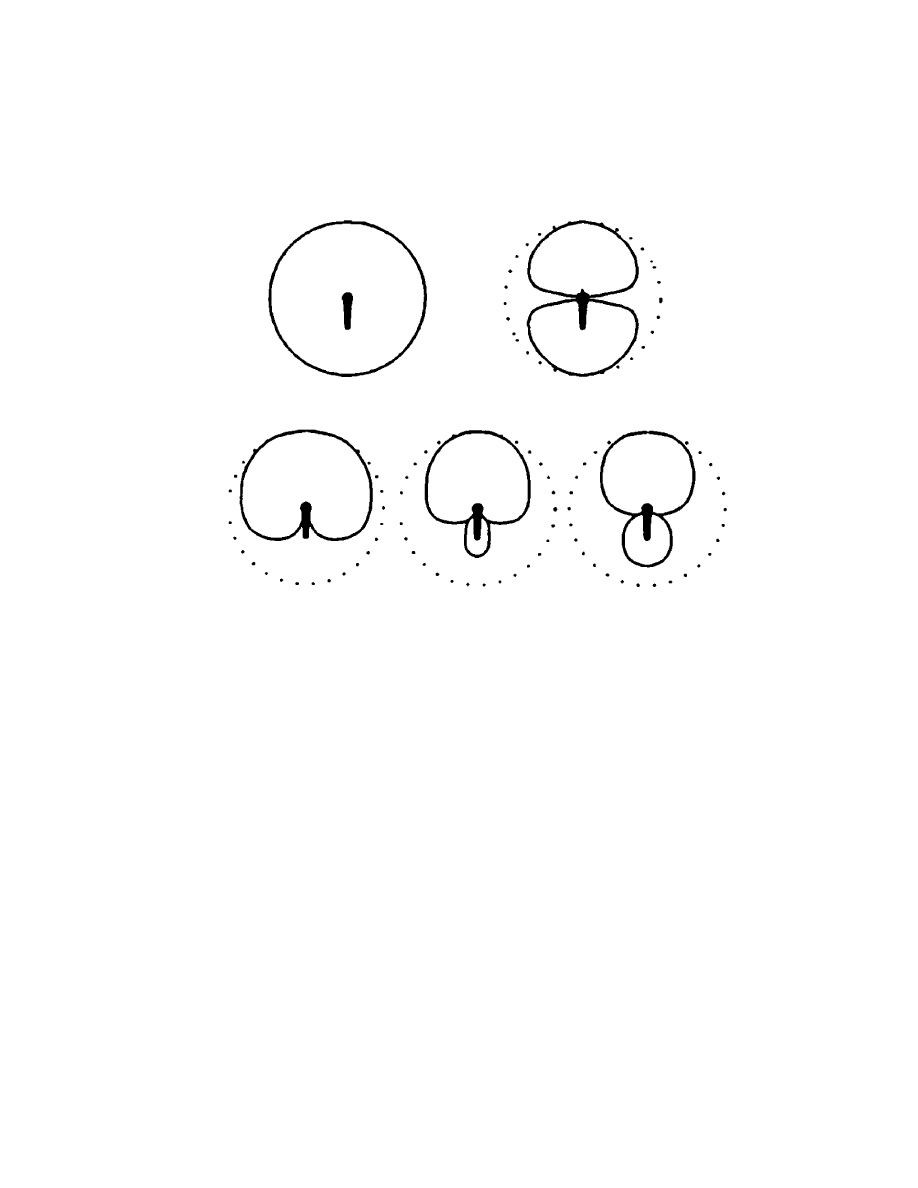ВУЗ: Казахская Национальная Академия Искусств им. Т. Жургенова
Категория: Учебное пособие
Дисциплина: Не указана
Добавлен: 03.02.2019
Просмотров: 12335
Скачиваний: 6

D
DIN: Deutsche Institut für Normung. A German standards organization that proposed a
set of connector configurations in the early 1960s. The standard MIDI connector is the 5-pin
DIN where:
Pin 1:
No connection
Pin 2:
Ground
Pin 3:
No connection
Pin 4:
+5V
Pin 5:
MIDI datastream
DIN sync: See pilot tone.
diode: A diode is a circuit element which will pass current in one direction only, from the
anode (positive) to the cathode (negative). Used to make DC from AC.
diotic: Literally, “with two ears.” Diotic generally refers to headphone listening whereby
the two ears hear the same signal, as opposed to monotic, where only one ear hears the sig-
nal. See also dichotic.
dip filter: A parametric equalizer with an extremely narrow Q, designed to remove noise in a
small band such as that from a camera or light.
dipole: In loudspeaker design, a dipole radiator is a system which radiates forwards and
rearwards with equal energy, but with opposite polarity. Examples of dipole radiators are
electrostatic loudspeakers and planar speakers. Some cone-type speakers have dipole radia-
tors. For a dipole radiator to have adequate low-frequency response, it must be very large to
prevent the rear wave from canceling the front wave. Also, the dipole radiator must not be
placed close to and parallel to a wall, working best when not near reflective surfaces.
direct box: See DI.
direct coupling: A connection between two devices that allows both DC and AC between
them.
direct current (DC): Current in only one direction. DC always has the same direction, from
the positive to the negative terminal. Compare with AC.
direct field: See reverberant field.

D
directional microphone: A microphone which does not have a spherical polar pattern, i.e., a
microphone which is not omnidirectional, such as a cardioid, figure-eight, etc. having an accep-
tance angle of less than 360˚. See directivity.
Omnidirectional
Bidirectional
Cardioid
Super Cardioid
Hyper Cardioid
Directional Microphones
directivity: Describes the angle of coverage of a loudspeaker system or microphone accep-
tance angle, both in the vertical and horizontal planes. High directivity equates to a narrow
angle of coverage. The directivity factor is a measure of the directionality of the sound output
of a loudspeaker. See also Q.
direct metal mastering (DMM): A system for cutting a metal mother on a record mastering
lathe, eliminating the lacquer master and metal master steps. Release pressings made from a
stamper are thus only two stems from the DMM and thus have less noise and distortion than
those made by the older, five-step process. The DMM process is also used in CD mastering.
direct output: A recording console output taken directly after the input module and main
channel fader, but before the panpot and output bus assignment switches. This output is
sometimes used to avoid crosstalk that may be introduced if the signal is allowed to flow
through the complete circuit.
direct positive: A optical (photographic) sound recording that, when processed, results in a
track that can be played and edited; now obsolete.

D
direct radiator: A loudspeaker which does not have a horn between the moving element and
the air is called a direct radiator. Most direct radiator-type speakers are for home use, while
horn-type speakers are preferred for sound reinforcement applications. Direct radiators gen-
erally provide smoother, more uniform response, while horns are much more efficient, pro-
viding a greater output level for a given power input. Also, horns have greater directivity,
which is desirable in sound reinforcement systems. See compression driver.
direct sound: (1) See reverberant field. See also free-field, critical distance. (2) The sound re-
ceived at the recording console from an electronic instrument when using a direct box.
Direct Stream Digital™ (DSD): A proprietary CD/DVD data format proposed by Sony and
Philips for use in the SACD . DSD bandwidth is normally 2.844Mb per channel (64 times
44.1kHz), with optional sampling rates of 32 or 128 times 44.1kHz,
yielding a slightly higher
data rate than that required by 24-bit/96 kHz resolution conventional A/D-D/A systems.
DSD uses a delta modulated ADC to generate a 2.8224MHz, 1-bit signal, a rate chosen as a
simple multiple of the lowest common high-fidelity PCM sampling rate, 44.1kHz. The 1-bit
datastream is recorded directly to disk, avoiding the decimation and oversampling stages, in-
herently improving the resultant audio quality, simplified error protection, and there is no
need to frame the data into words. Sony claims that the sampling rate is so high that it more
nearly approximates the original analog signal, allowing equalizers and other effects proces-
sors to better simulate analog effects. It is claimed that DSD can have frequency response up
to 1MHz, or up to a dynamic range (within the audio bandwidth) of 120dB, equivalent to
about a 20-bit resolution. A number of DSP algorithms are available which allow the opti-
mization of either bandwidth or dynamic range. [Note that these benefits apply only to
those players which support the DSD standard, as replay on any conventional CD, DVD or
other digital format would require the decimation and framing steps.]
Direct Stream Transfer™ (DST): Philips’ proprietary technology for lossless 2:1 data
reduction in digital recordings on SACD. DST is optimized for audio-type signals, allowing
sufficient storage capacity for double the old CD standard of 74 stereo minutes. By
incorporating DST into the SACD standard, it is possible to store two complete 74-minute
versions of audio material so as to combine a stereo DSD track, and a 6–channel surround
mix, plus other data, text, graphics, and video, all on the single, high-density DASD layer.
direct-to-disc: A type of analog LP mastering in which a master tape is not used. The signal
directly from the control console is used to cut the original acetate disc. This means a direct-
to-disc recording cannot be edited, and is made live.
direct-to-disk: Recording digital audio data onto a hard disk for replay or editing.
direct-to-two-track: A method of recording in which the instruments and vocals are mixed
and recorded directly onto a stereo half-track or DAT. If analog, no further changes or
remixing is possible. The fidelity, edibility, and relatively low-cost of direct-to-two-track
digital recording has revived the popularity of this medium for making master tapes, espe-
cially those intended for release on CDs. Also called live-to-two-track.
DirectX: The most common audio effects plug-in format used by Windows™ software.
discrete: Refers to a 1:1 relationship of recorded tracks on an audio medium or film print
and the resulting number of speaker channels. Contrast with matrixed sound.

D
discrete 6-track: Traditionally means the five-speakers-behind-the-screen system made
popular by the Todd-AO 70mm process (although first used for Cinerama). Today the term
sometimes means six nonmatrixed tracks, assigned to L,C,R,LS,RS,Subwoofer. See also 5.1.
discrete output: A direct output from a mixer channel, which services only that one chan-
nel.
disk-at-once: A CD production process where the entire disc is written in one burn; the la-
ser is never turned off. Ideal for audio, disk-at-once mode allows gaps between tracks of any
length (except the first track, which must have a 2-3 second gap.) Compare with track-at-
once.
dispersion: (1) The spreading of sound waves as they leave a loudspeaker. (2) Another term
for refraction.
displacement: The distance between some measured position of a moving object, e.g., a
speaker cone, and its static position. Also applies to the position of air molecules in a sound
wave. See rarefaction.
distant miking: The opposite of close miking. In recording, the placement of one or more
microphones relatively far away from the sound source. This technique picks up a substan-
tial portion of reverberant sound, and is therefore used to make most classical or orchestral
recordings to capture the sound as closely as possible to that experienced by an audience. In
the studio, close and distant mics on any instrument or group may be blended at the mixer
to achieve the desired sonic image. See depth.
distortion: Also called correlated noise. Any (usually) unwanted sound which varies with
the input signal. (1) Any undesirable change in the characteristics of an audio signal of six
types: The two types of (i) nonlinear distortion are intermodulation distortion and harmonic dis-
tortion. Other types of distortion are (ii) frequency distortion (pitch-shift), (iii) phase distortion
(time shift), (iv) transient distortion, (v) scale (volume) distortion, and (vi) frequency modulation
distortion. There are other factors which cause music reproduction to be untrue to the origi-
nal but which are not considered distortion, such as background noise, and a lack of direc-
tional realism and proper ambience due to the use of too few channels of reproduction. See
noise. (2) A sound modulation technique whereby the original waveform is distorted inten-
tionally.

D
dither: A noise-based rounding method used to add a tiny amount of controlled noise to a
digital audio file to make other, more objectionable errors less obvious and/or to convert
from one word size down to a smaller word, e.g., from 24-bit resolution to 16-bits. Redither-
ing is a dithering process used in digital-to-digital signal processing to distinguish it from
the dithering process used during the original A/D conversion. There are several ways to
dither:
(1) Add white noise at about half or one-third the value of the LSB, or half the level
that a system can transmit. Thus, for a 16-bit converter encoding a range of 2V,
the LSB is equivalent to a difference of 30.5µV (2÷65,536V), yielding dithered noise
of about 10-15µV;
(2) Second-Order dither in which the dither signal (white noise) is processed by a high-
pass filter to remove low-frequency components. This makes the noise less appar-
ent to the ear, since humans are less sensitive to high-frequency noise than other
levels;
(3) Noise-shaping in which the dither signal is run through a set of filters to provide
the most energy in regions where the ear is the least sensitive;
(4) (Triangular Probability Density Function) where before the noise is shaped, it has
a different spectral content than ordinary white noise. It has better noise modula-
tion performance, which is how the noise affects the signal itself;
(5) Sony’s SBM (Super Bit-Mapping) where the audio is run through a processor with
an algorithm that maps a series of higher-resolution samples to a series of lower-
resolution samples;
(6) The Apogee UV-22, which is not really dither. Instead, it uses a periodic signal
centered around 22kHz that has good performance in terms of audibility and
noise modulation. Placing the signal this high in the audio spectrum makes it
very difficult to hear and produces fewer effects on the character of the signal.
DLL: Dynamic Link Library. Files used by PC-type computer application programs to pro-
vide additional functionality to the computer’s operating system. The equivalent of an ex-
tension file on a Mac.
DLS: DownLoadable Samples. A standard which allows multimedia games or other pro-
grams to contain samples which would be downloaded to the playback hardware. This is a
hybrid between streaming digital audio (direct audio from CD-ROM, for example) and MIDI,
which alters predefined sounds. DLS is an attempt to solve the problems inherent in the
ambiguity of the GM specification and the somewhat random sounds produced by the play-
back hardware. DLS-1 specifies: 16-zone multisampled soundbanks with 128 zones for
drum banks, pitch-shifting, ADSR for amplitude and pitch, and LFO for amplitude or pitch.
DLS-1 was ratified by the MMA in 1997. See DLS-2.